
Hello and welcome to your weekly FOIAball. No need for a lengthy preamble except to note this story is free for all subscribers.
But to continue bringing big scoops like this, we need your support.
So become a paid FOIAball subscriber today. Your first month is just one dollar.
“We can make sure it’s directed to Bruins For Life.”
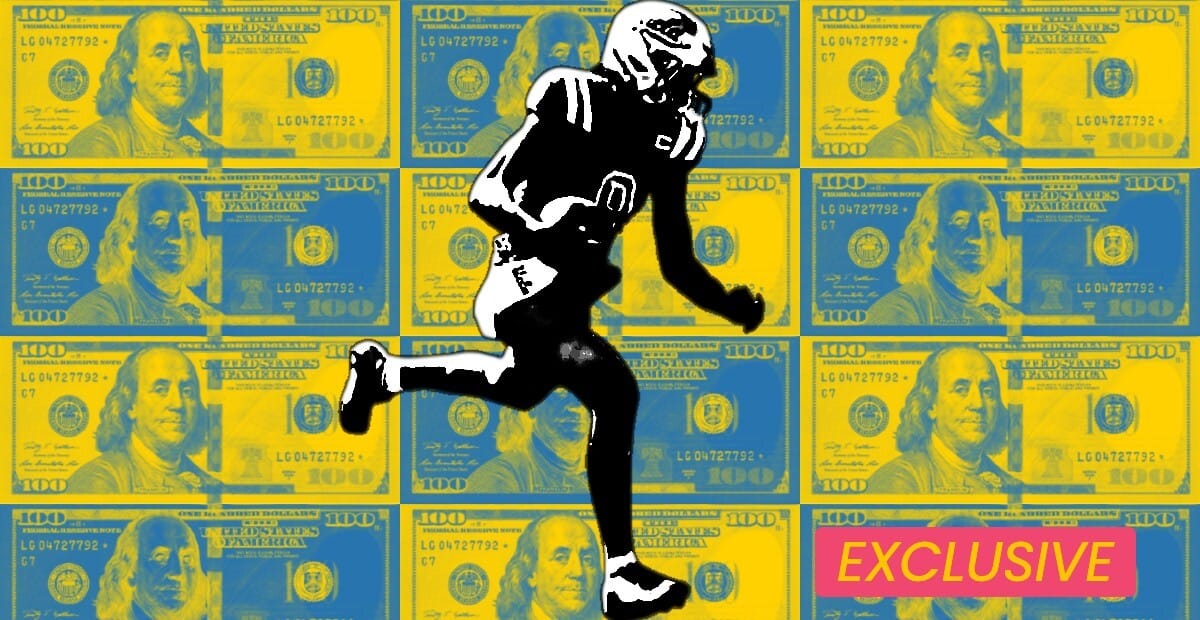
On April 10, 2025, reports revealed that Tennessee quarterback Nico Iamaleava wanted a bigger NIL deal with the Volunteers.
The timing, a few days before the transfer portal opened, wasn’t coincidental. It sent a clear message: Someone out there would pay him a lot more.
That same night, donors at the school that landed him pledged $60,000.
But UCLA didn’t have those boosters send checks to its NIL collective, Bruins for Life.
Instead, its athletics department steered the money to a local charity for at-risk youth.
Which is run by the co-founder of Bruins for Life.
When the Supreme Court upended college athletics in 2021 and kicked off the Name, Image, and Likeness era, it created a torrent of loose cash.
NIL collectives quickly formed to funnel that money to programs. Ostensibly, they worked as facilitators to help student-athletes find advertising deals and earn compensation.
But the system had little oversight, with eager boosters and creative accountants willing to game the system.
Some of these NIL firms applied for tax-exempt status, known as a 501c3.
In this new world, if you were a local pontoon boat dealer or hot tub magnate, instead of under-the-table wads of cash, you could essentially give directly to your team’s best players.
And write it all off on your taxes.
The IRS quickly determined these NIL collectives were not there to help the community. In a series of rulings beginning in 2023, the agency determined collectives didn’t merit 501c3 status.
Its logic was fairly straightforward. Because NIL collectives "distribute[d] the majority of funds received to student-athletes, and not for a charitable purpose,” they weren’t charities.
While collectives could still apply for a ruling, the IRS made it clear the barrier for approval was high.
Newer ones skipped that step entirely.
When Texas Aggies United launched after the ruling, it didn't bother trying, noting at its onset that contributions to it were not tax-deductible.
Bruins for Life, UCLA's official football collective, debuted on Dec. 3, 2024.
It was co-founded by James Washington, a former safety for UCLA with an impressive on-field pedigree.
In 1985, he was named MVP of the Fiesta Bowl after the Bruins beat the Miami Hurricanes 39-37. In the NFL, he won two Super Bowls with the Dallas Cowboys.
According to his LinkedIn, he worked for UCLA for six years as a director of development, spearheading major gifts
His partner in the endeavor, John Manuck, is an engineering entrepreneur who started a high-tech polymer firm.
In 2013, his company hosted a visit from Barack Obama and Joe Biden, who announced a $350 million investment in a 3-D printing partnership that included Manuck’s firm and the Tennessee laboratory that refined uranium for the first nuclear bomb.
College football really does have it all.
Bruins for Life’s stated mission is to "create pathways for UCLA athletes to explore NIL opportunities," helping them “monetize their brand.”
On its website, the collective explicitly states it is not a 501c3 and that donations to it are not tax-deductible.
Or, stated. Its website was taken down this week.
But before then, when visitors clicked to donate, it didn’t tell them to mail money to the NIL collective.
Instead, it listed Shelter 37, Inc., a tax-exempt charity that helps provide opportunities and mentoring for youth in the Los Angeles area.
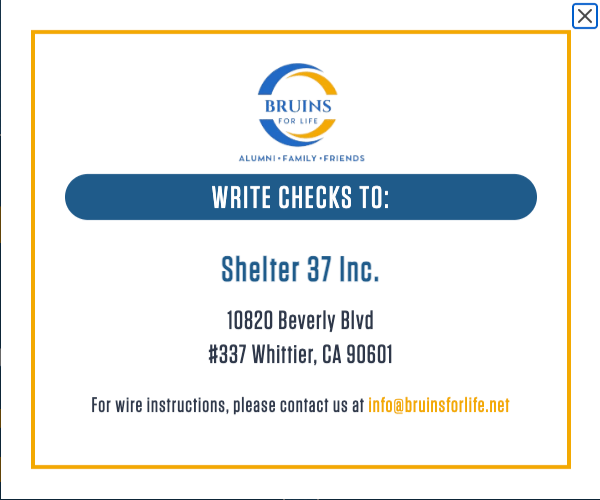
Shelter 37’s president is James Washington.
The former chairman of its board?
John Manuck.
The IRS grants charities tax-exempt status on the grounds that private money going directly to help others is a public good.
It’s an essential tool to help funds flow to people who need them. Especially because donors are happy to oblige when that giving can lower their tax bill.
But as the IRS noted in its NIL collective ruling, charities are expected to further the public well-being.
And anyone who watched the first few UCLA games this year would … never mind.
Shelter 37, though, is a 501c3 charity that is "eligible to receive tax-deductible charitable contributions."
Its 2023 Form 990 details the organization's mission: “Provide educational training and programs to underserved and disengaged young adults in order to equip them with skills and knowledge.”
It does so through a hodgepodge of activities that include mentorship, tuition support, public appearances by Washington, and a home ownership program.
The website doesn’t give the appearance of an extremely active organization, littered with stock photos.
Its events page has just two entries in the past two years, both Thanksgiving turkey drives. Its blog has one post since November 2021.
Under sponsorship opportunities, it makes a small mention of UCLA, saying that fundraising events like its golf tournaments can cover the cost of additional programs, which include a youth football camp hosted by UCLA.
But an active relationship exists behind the scenes.
Emails from UCLA’s fundraising department, obtained by FOIAball, show the school is steering money to the charity, with explicit notes that it be earmarked for football NIL.
In one email, a booster forwarded the approval message for a $15,000 grant from a donor-advised fund to Shelter 37.
“This is the grant payable to UCLA Football,” they wrote.
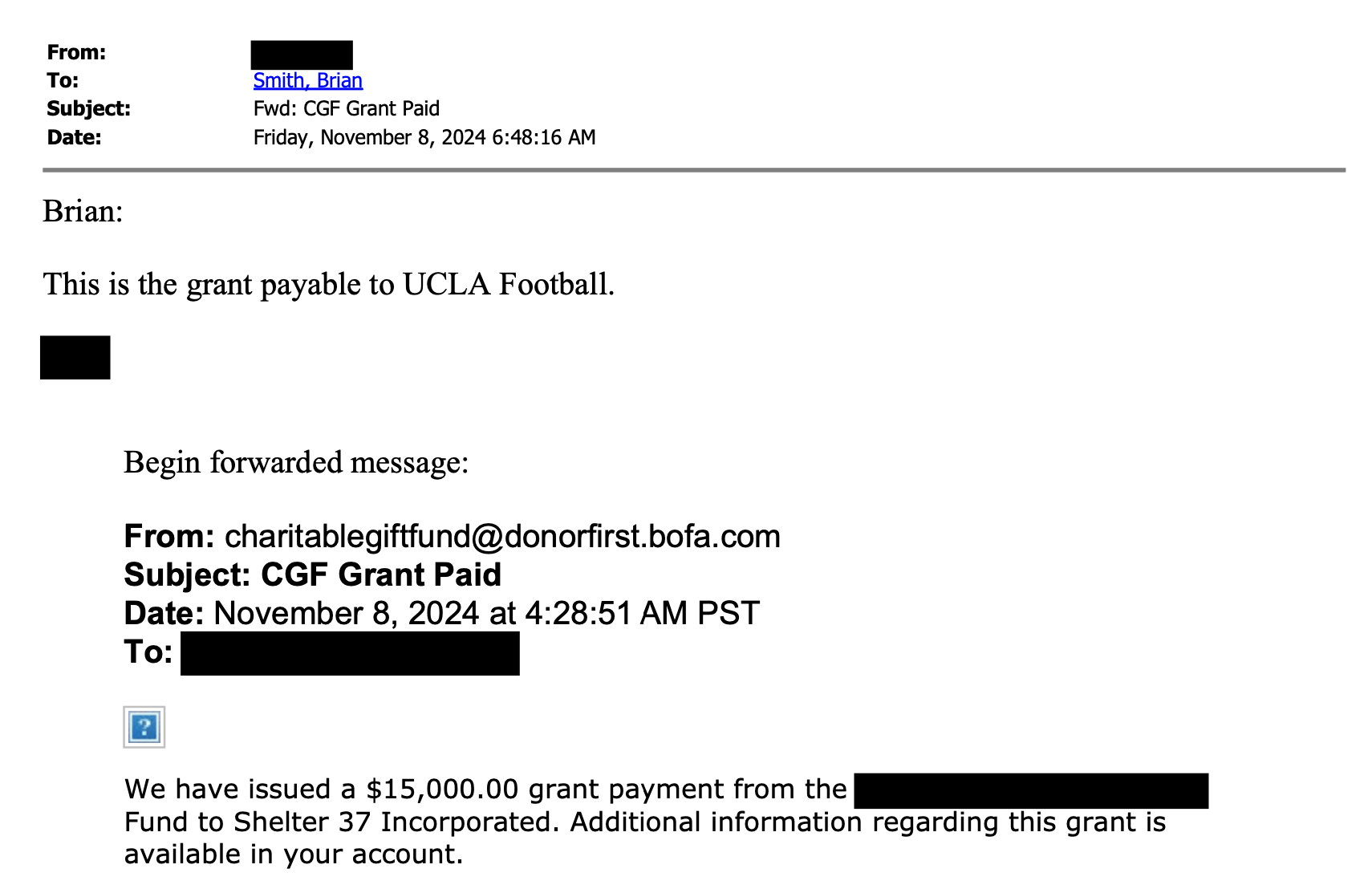
FOIAball spoke with several prominent attorneys and professors well-versed in tax law.
We initially presented the situation as hypothetical.
Bloomberg tax columnist Andrew Leahey told FOIAball, “If that is indeed what is happening, it is, potentially, a huge issue.”
When sent the documents to review, he replied with a grimace emoji.
“Pretty blatant, pretty bad,” Leahey added. “Woof.”
After viewing the emails, Lloyd Hitoshi Mayer, a Notre Dame professor who focuses on non-profit tax law, said what was happening was clear.
“UCLA athletics is encouraging their donors to engage in fraud.”
Bruins for Life was publicly announced in December 2024. Behind the scenes, UCLA’s athletics fundraising team was already working to wrangle donors.
In November, the school prepped an email to alumni pledging a $500,000 match for donations to Bruins for Life.
UCLA’s associate director of development sent the draft email to Washington to review.
He didn’t send it to the Bruins for Life email Washington had. He sent it to the contact email for Shelter 37.
“Please see the draft email copy below [that] we've written per our discussion today to announce a gift match opportunity to Football Alumni.”
It’s unclear if Washington made any edits, but he replied, “John and I truly appreciate all the help your team has given us to jump start Bruins for Life.“
A month earlier, the school was reviewing payment options for donating to Bruins for Life.
Washington sent over three. Wire information for Bruins for Life, checks made payable to Bruins for Life LLC, and one other.
“Wire: If donors want the Tax Deduction,” Washington wrote, listing Shelter 37.
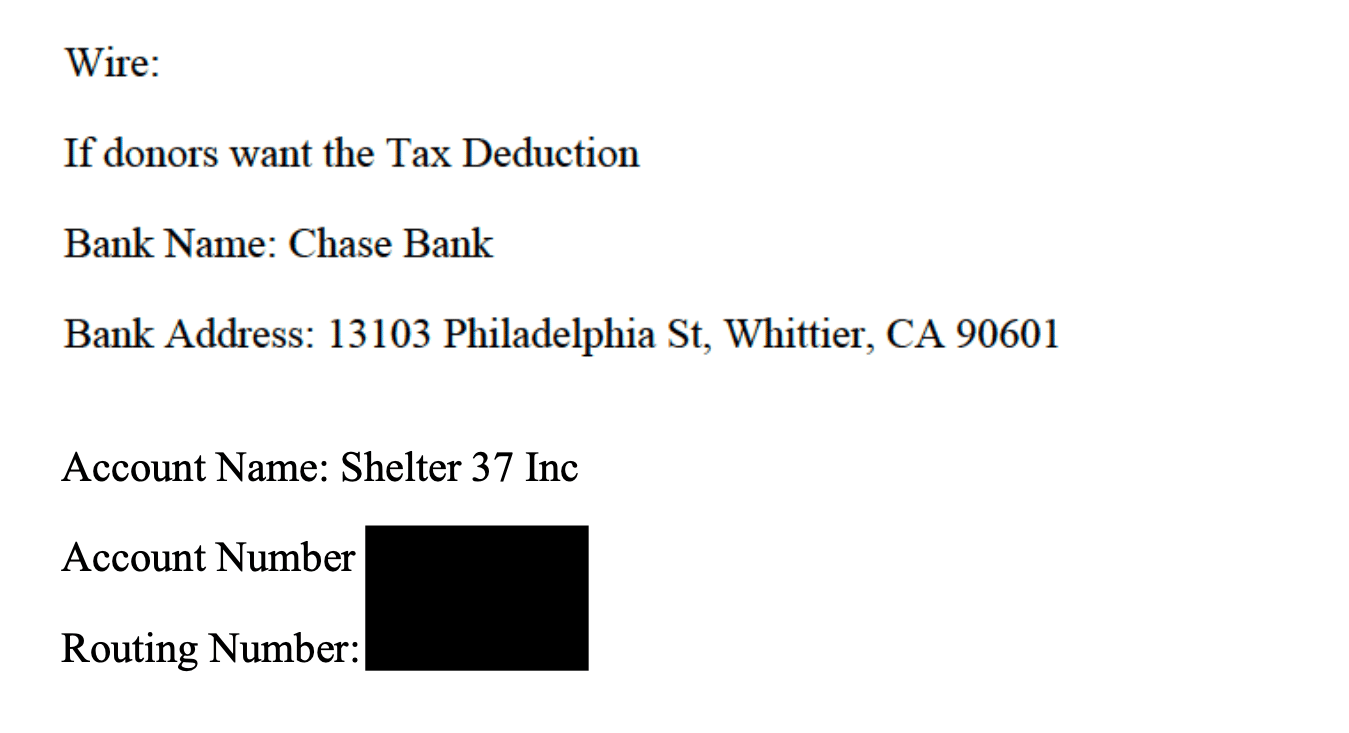
When reached by FOIAball, Washington originally called Bruins for Life an “alumni club” and denied it was ever an NIL collective, before amending that statement, saying the NIL plan never “came to life” and it “pivoted to becoming an alumni club.”
When asked about his specific email regarding the tax deduction, Washington paused for eight seconds before discussing work Shelter 37 did with the school, including football camps.
When pressed about the lack of events on Shelter 37’s website, Washington said, “Well, you can go through the history of 32 years of me impacting lives and changing lives forever.”
FOIAball could find no evidence online of any recent camps hosted by UCLA football. A link on its athletics website for football camps points to a URL from 2013.
The school’s emails with donors make no mention of charitable events.
Internally, UCLA circulated the donation options, noting: “Shelter 37 (501c3) Wire Instructions (Requires Pre Approval from James Washington).”
An employee asked to keep that third option under wraps.
“Can we update the two direct payment options (exclude Shelter 37 option) to the one sheet on payment options?” they wrote, ccing UCLA’s Chief Development Officer and head of fundraising.
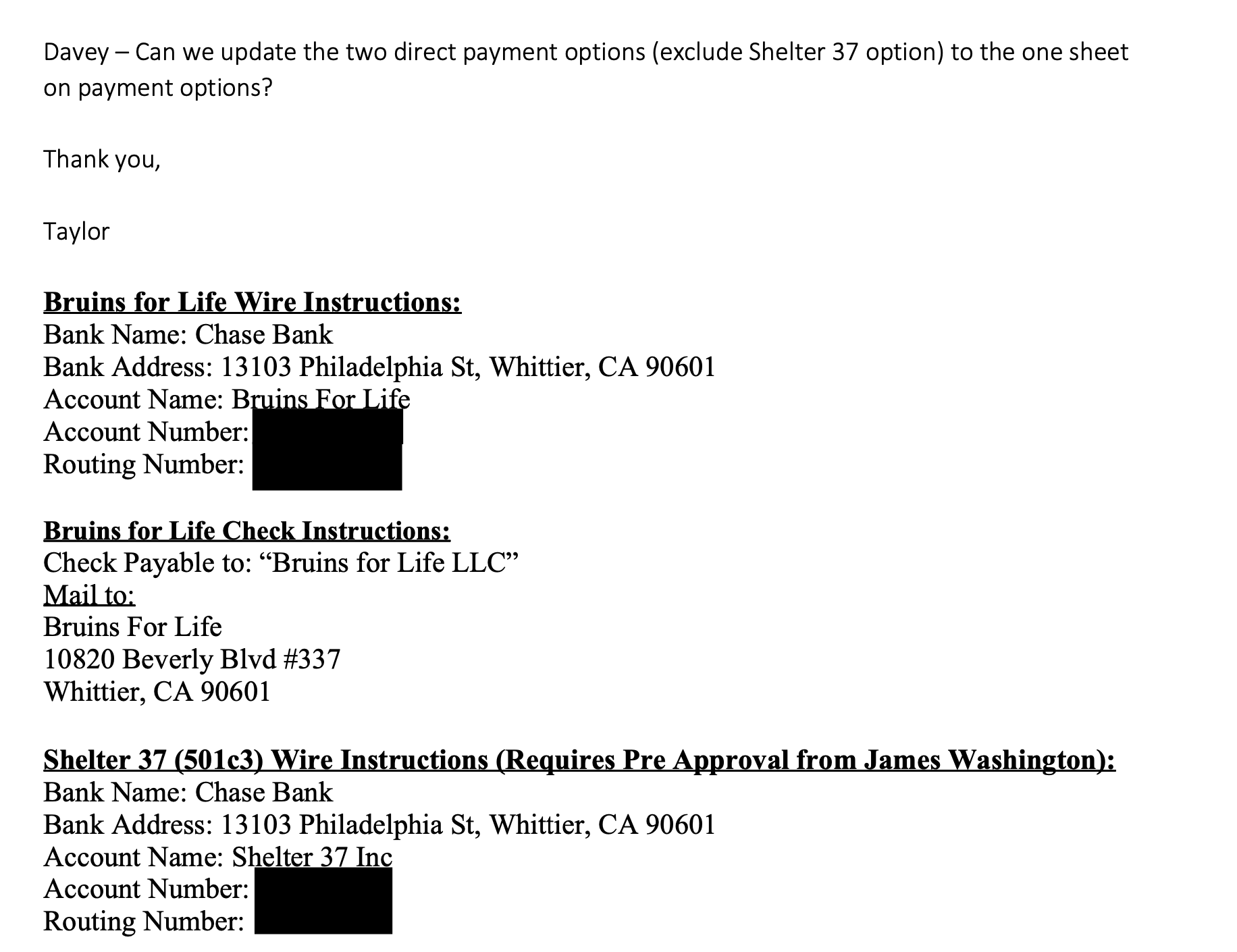
But not because the school wouldn’t be using it.
Over the next few months, the school ensured certain donations that were sent to Shelter 37 were flagged for the football NIL.
In an email string from May to June, one UCLA official spelled it out.
Writing under the subject line “Football NIL Support,” they wrote: “I’m writing to confirm that during the month of May 2025, you will be redirecting the $13,700 pledge to UCLA’s Football NIL collective ‘Bruins for Life.’ Please note that UCLA Football NIL Collective ‘Bruins For Life’ partners with 501c3 ‘Shelter 37.’”
They then asked to be given a heads-up when the money was mailed, so the donation to the charity would be marked for the NIL collective.
“Prior to sending each of your checks, please email us so that we can give James a heads up, confirm receipt, and make sure it’s directed to Bruins For Life.”
A couple weeks later, the employee followed up.
“Just wanted to check back to confirm whether you’ve mailed your May check to Shelter 37 yet? We need to alert James …. that it’s on its way so that it’s directed to UCLA Football NIL, Bruins for Life. Thank you again for your generous support,” they wrote.
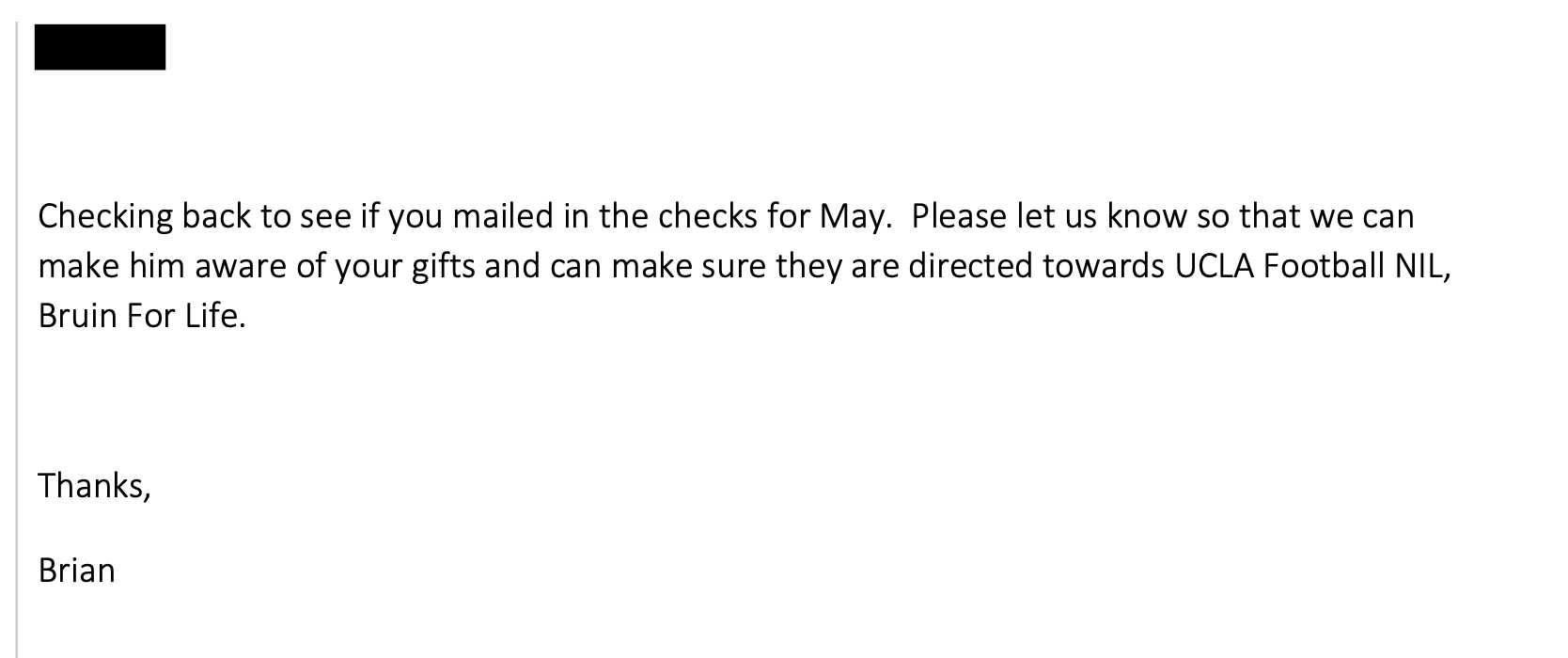
When the donor finally confirmed the check was sent, the UCLA employee reached out to Washington to make sure he knew what the money sent to the charity was really for.
“Checking back if you received the $6,800 check from [redacted] to Shelter 37 to be used for Bruins For Life. Per this email string, it was sent out a day after [redacted] check. You confirmed receiving [redacted] check for $6,900 on 6/13.”
Washington told FOIAball he was unaware of UCLA ever discussing donations with him. Manuck, when reached for comment, told FOIAball to speak to Washington.
In a statement to FOIAball, UCLA's athletics communications director Liza David said, "UCLA Athletics operates with integrity and transparency, in a manner that is consistent with industry best practices. Our development team educates potential donors on a range of giving opportunities, including avenues to support our student-athletes.”
The school did not address any of the specific questions FOIAball asked.
The workaround appears to center on the use of donor-advised funds.
Donor-advised funds are a way for individuals to earmark money for charity without actually giving it away, claiming an immediate deduction and dispersing donations later.
Major financial institutions such as Fidelity, Charles Schwab, and Bank of America all run donor-advised funds, where they hold money contributed by individual donors. These funds then review and approve the charitable giving.
They all sent money to Shelter 37.
The emails obtained by FOIAball show UCLA officials pointing donors to Shelter 37 after other NIL giving was denied.
In October 2024, a redacted individual forwarded a $30,000 denial from the National Philanthropic Trust.
It cited the IRS’s findings.
“Unfortunately, this grant recommendation will be denied. In light of IRS guidance on NIL Collectives … NPT will no longer approve grants that could be used to support the development of paid name, image, and likeness opportunities for collegiate student-athletes. The IRS indicated that such opportunities provide private benefits to student-athletes that are not incidental; as such, a DAF cannot be used to support such opportunities or organizations that facilitate such opportunities.”
The UCLA employee who was forwarded the denial passed it along to the rest of the school’s fundraising team.
“Just as an FYI. Here is info for Shelter 37 for DAF gifts.”

The need for an approved home for donor-advised funds stems from a massive NIL firm shutting down its charitable giving option.
In an email to a donor that same month, a UCLA official wrote, “Earlier this week, we received information that Blue Print Sports, who you sent your DAF gift to this past year, will be closing down their Charitable Giving option for all schools across the country … For Football NIL, Bruins For Life is partnered with 501c3 ‘Shelter 37’ and can accept gifts from a DAF.”
The email neglected to mention that Blue Print Sports shut down its 501c3 arm after the IRS ruling.
According to Sportico, the firm was facing inquiries from both the federal government and state attorneys general about the legality of its giving.
Blue Print’s legal counsel said the charitable endeavor had “no path forward.”
But UCLA had found a path forward for DAF.
On Nov. 8, the school got an email from a redacted donor about an approved grant from a DAF with Bank of America.
“We have issued a $15,000.00 grant payment from the [redacted] Fund to Shelter 37 Incorporated.”
“This is the grant payable to UCLA Football,” the donor wrote above the message.
A few days earlier, UCLA gave Washington a heads-up about the money.
“James, [redacted] has initiated a check for $15,000 to Shelter 37 which should be directed to Bruins for Life. The check will be coming from [redacted] Fund.
Washington denied that Shelter 37 ever passed money to Bruins for Life.
But when read the above email, he said, “I would have to go talk to my accountant and the person that was running that particular wing.”

Washington did admit that his charity paid players, saying, “We were helping the community, kids would get paid, and they would come out to go to events.”
Even if no money passed between Shelter 37 and Bruins for Life, that’s a loophole that the IRS has rejected.
Notre Dame’s Mayer told FOIAball that the IRS found “that even paying the athlete to do an ad for charity, if the real purpose of this is to compensate the athlete, not to promote the charity, then you have a problem. It's not necessarily wrong for a charity to pay for a spokesperson. But the problem is the NIL collective taints it by saying, ‘Okay, the real reason here is to pay the quarterback.’”
Another email mentioned a $150,000 from another DAF.
“Generous supporters [redacted] and [redacted] have directed a check for $150,000 to Bruins for Life via Shelter 37. The check will be issued by Fidelity Charitable.”
In April 2025, a redacted donor sent an email noting his charitable request had been submitted to Schwab Charitable.
“The check should arrive to Shelter 37 in the next 7-10 business days,” they wrote.
The subject line was “Football NIL support.”
In the copy below, again, UCLA appeared to be steering it there.
“For your $10K gift to support UCLA Football’s collective Bruins for Life, which partners with 501c3 Shelter 37, please make your check payable to ‘Shelter 37.’ Please let me know when your Shelter 37 check is mailed, as I’ll reach out to James to give him a heads up and to confirm when it is received.”
It’s behavior that raises numerous red flags under current tax law.
“Shelter 37 would be a conduit, not exercising control or discretion over the donations,” Leahey, Bloomberg’s tax columnist and a tax law professor at Drexel, said. “The NIL is not charitable, as it exists to pay athletes for their NIL deals and directly benefits identifiable individuals. That is about as textbook an impermissible private inurement or private benefit situation as you can get.”
In calling it fraud, Notre Dame’s Mayer cited the National Philanthropic Trust’s denial, saying that “Once [UCLA] learned the donor-advised fund … would not approve a grant directly to the NIL … they told the donors, ‘well, just tell them to give it to this legitimate charity, 501c3, Shelter 37. But we'll make sure it gets to Bruins for Life.’ And that's clearly just doing an end run around.”
Because of the redactions in the emails, it's unclear if UCLA was only steering money from DAF to Shelter 37 or from individual donors.
A Feb. 6, 2025, email showed that a redacted donor gave $100,000. It does not mention a DAF.
“It’s my understanding that [redacted] made a second $50,000 gift in December 2024 to Shelter 37 to support Football NIL,” a UCLA employee wrote.
If UCLA were soliciting money from individual donors, that too could be a form of tax evasion, Mayer told FOIAball.
When asked if he had a comment about experts viewing the activity as potentially fraudulent, Washington said, “No, I do not.”
After speaking with FOIAballl, the website for Bruins for Life was taken offline.
The charity workaround comes at a time when UCLA’s athletics department has faced harsh scrutiny from donors.
In October, the Los Angeles Times spoke to a dozen high-level donors to the program who alleged “rampant dysfunction.”
Of particular ire was a situation in 2023, where the school accidentally attached a database that detailed top donors' lifetime spending on the program.
It was an error the school never acknowledged or apologized for, according to the Times.
“What’s happening now feels like watching a trainwreck in slow motion,” a donor told The Times. “What we’re seeing isn’t just a rough patch. It’s institutional apathy. And if the administration doesn’t care, why should fans and recruits?”
While the emails detail close to a half-million dollars going to Shelter 37 for UCLA’s football team, FOIAball cannot provide a total amount.
That’s because the emails UCLA provided are only the first batch of documents they released to us.
So there’s possibly plenty more to come.
Update 11/20/2025: After publication of this story, Shelter 37’s 2024 IRS 990 form was published on ProPublica’s tax-exempt organization database.
While it is not live yet on the IRS’s searchable database, the form shows that Shelter 37’s revenue jumped by over four million dollars in 2024, from $800,000 to $4,800,000.
In its statement of program services, Shelter 37 said it raised $3.6 million for the Bruins for Life NIL program, "designed to support UCLA football in cultivating and securing NIL opportunities."
By contrast, the charity raised just $200 to provide scholarships to at-risk youth.
In reviewing the form, Bloomberg’s Leahey said that the 990 “raises more questions than it answers.”
He noted the charity published no conflict of interest policy, which might be in place to prevent someone from being in charge of both a tax-exempt charity and an NIL program.
“The whole thing reads to me like there is a pot of money, restricted based on what donors earmarked it for, waiting to be paid out to players for NIL,” Leahey said.
Enjoyed this scoop? Support our work by becoming a paid subscriber today!
How to make chicken pot pie your own

In 2010, I got three things that helped me become the cook I am now.
Spurred by a new apartment, I got a high-quality chef’s knife that I still use today. At Target, I grabbed a giant bamboo cutting board, a collab with Giada de Laurentis that lasted until a recent upgrade.
And for Christmas, my mom got me a copy of Thomas Keller’s “Ad Hoc at Home.”
The book spoke of this deep, loving relationship with the food you make that changed how I thought. And it was littered with hacks, tips, and techniques I still use today.
But I haven’t made a recipe from it in, well, 15 years.
That’s because Keller takes these simple, homey recipes and adds a level of excessive refinement that blows well beyond the point of absurdity.
First, I made his braised short rib.
Almost all recipes involve simmering the sinewy meat with carrot, celery, onion, red wine, and beef stock. But Keller has you cook those five ingredients together the day before, sans short ribs, to ensure your braising liquid is properly flavored in advance.
I did that step once, and never again. Made no difference.
Then I attempted his pot pie.
The dough involved three different processes for working butter into flour: pushing it between your fingers, through the tines of a fork, then kneading by hand.
The veggies are another ordeal. Diced potatoes, carrots, and pearl onions are boiled in three separate vessels, each seasoned with exactly one thyme sprig and eight peppercorns.
Why not one pan, three thyme sprigs, and 24 peppercorns, I’ll never know.
More enervating is that celery requires a fourth pot, blanched in only salted water.
The bechamel, despite never containing a single solid entity, is to be passed through a fine mesh sieve.
I also never did any of that again.
But, like I said, the book was useful. It really helped me care about what I served. And I’ll never forget his ratio for pie dough, one-to-one sticks of butter to cups of flour. For a full pie, you need two and a half each.
But instead of his arduous process, I just run the frozen sticks over a box grater and toss them into the flour with a half-tablespoon of salt.

Most recipes warn you to be extremely judicious when adding water, fearing you’ll oversaturate your dough. For years, I measured out Keller’s four exact tablespoons.
But unless you pour in a full pint glass, it’s going to be fine. The same goes for overworking. Directions that tell you to stop the instant the dough comes together ask you to pinpoint an ephemerality. Six more kneads ain’t gonna ruin it.
For veggies, I just sautee in a skillet. All at once. Alongside carrot, onion, and celery, I’ve been using turnips instead of potatoes, which add a nice peppery bite. Alongside lots of salt, a real big pinch of cayenne gives a lively undercurrent to the hearty filling.
The chicken I poach in stock. Then, that enriched stock is used instead of milk in a bechamel. There’s no place for a classic French technique in an iconic American dish
That concoction, simmered until thick, can be doctored however you please, so long as you aim for zing and pep.
Last weekend, I used sauces Worcestershire, hot, and fish; heavy cream; and Dijon mustard. When you start sticking the spoon in your mouth after every single stir, you’ll know it's ready.
When that’s thick enough, pour over the veggies and shredded chicken and cook until melded.
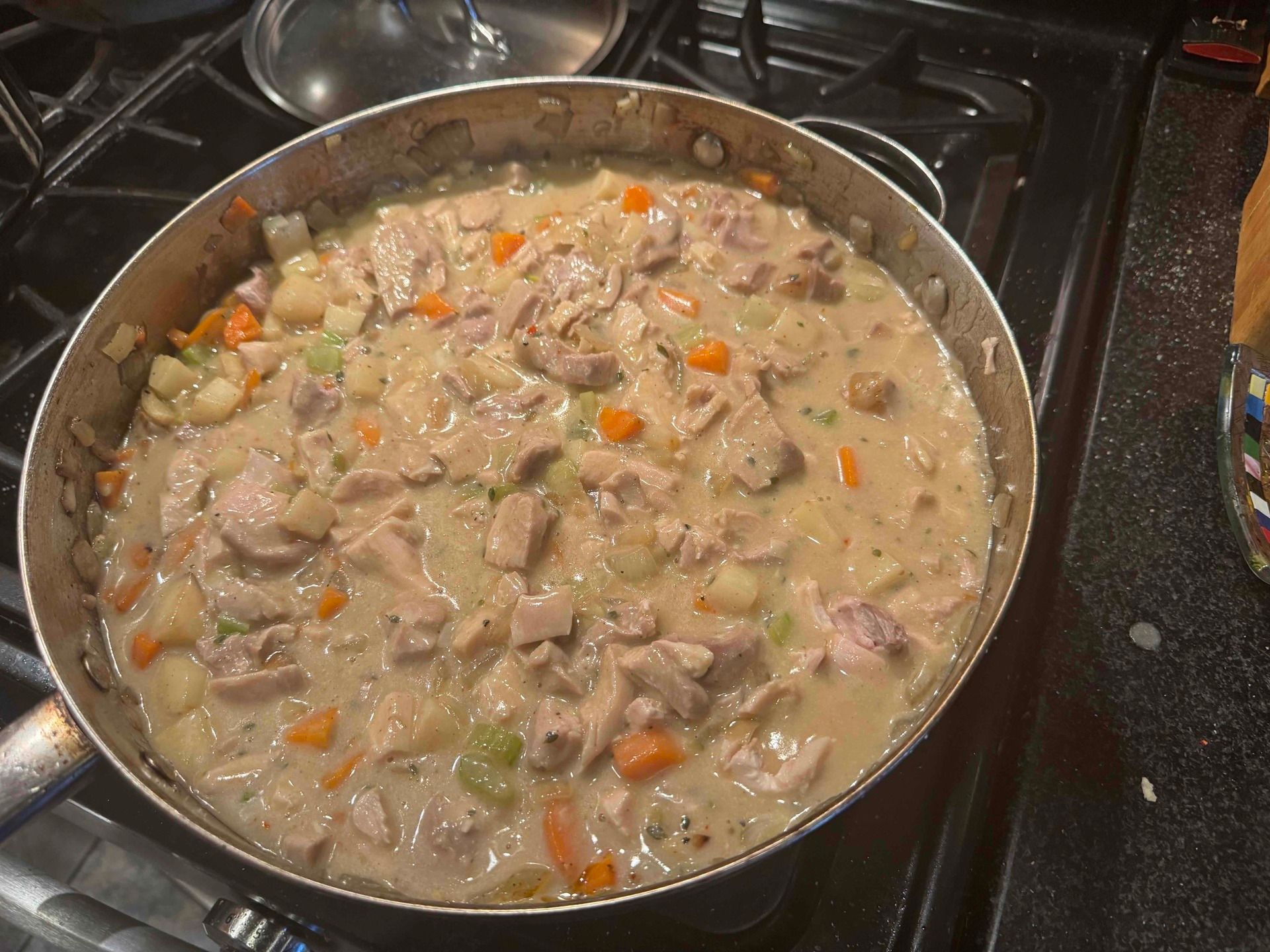
Then use a whole bag of peas. One thing that always drove me mad is that Keller doesn’t include peas in his pot pie.
It’s a good reminder that even those who’ve made it to the apex of their fields have raging blind spots.
(Something that’s really been hammered home this week.)
Once those heat through, roll out your dough, and assemble your pie. I’ve found that a healthy glug of milk or cream added to a beaten egg helps the wash spread on much easier.
Use your scraps to decorate your pie, for there is nothing wrong with taking someone else’s recipe, discarding what you don’t like, and making it your own.
In fact, that’s how you become an incredible cook.
Even if your filling this weekend turns out way too runny.
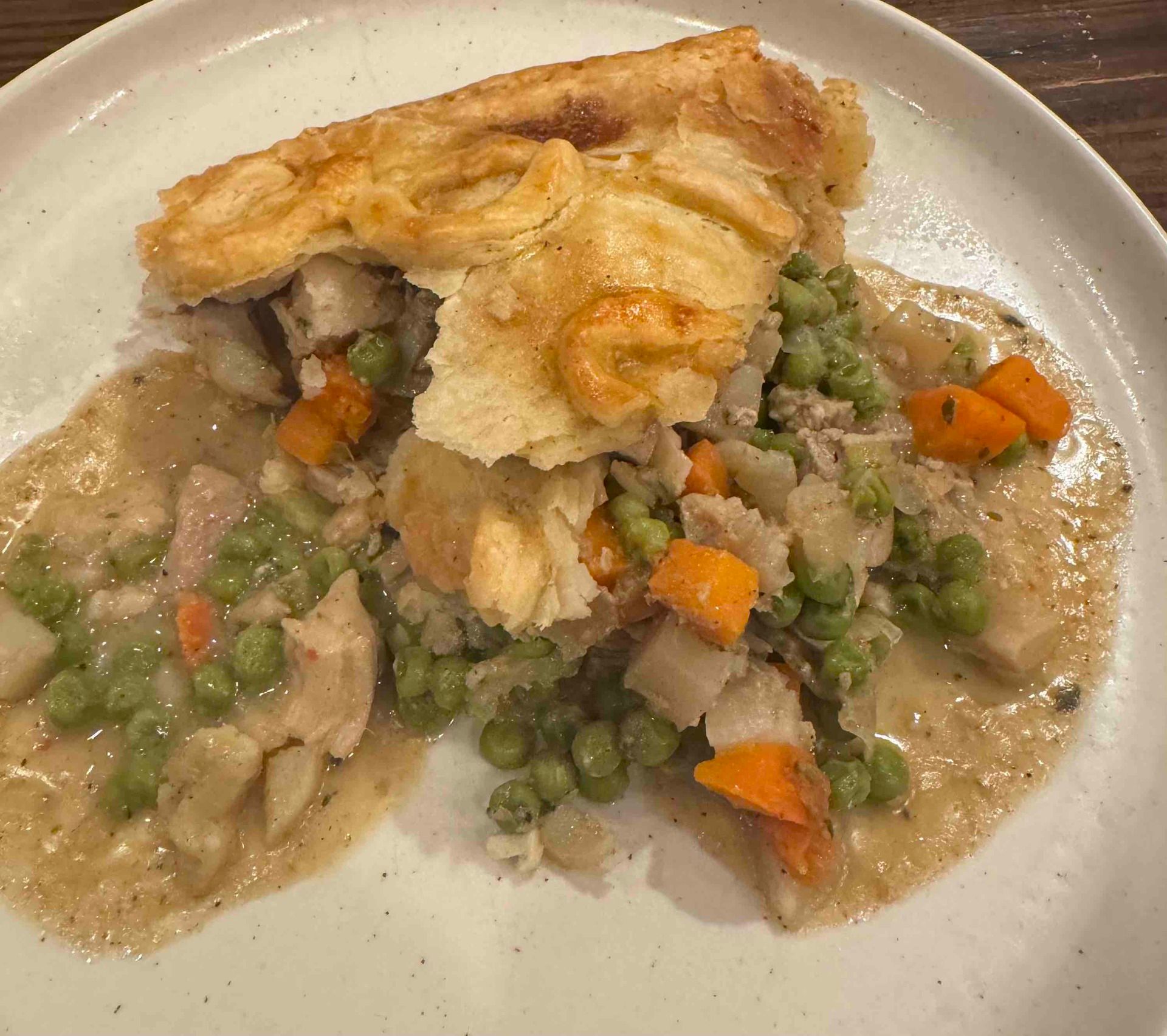
That’s all for this week, except for one thing.
If you haven’t hit the upgrade button yet, now is the time.
We’ll see you next week.
Nico Iamaleava via YouTube
